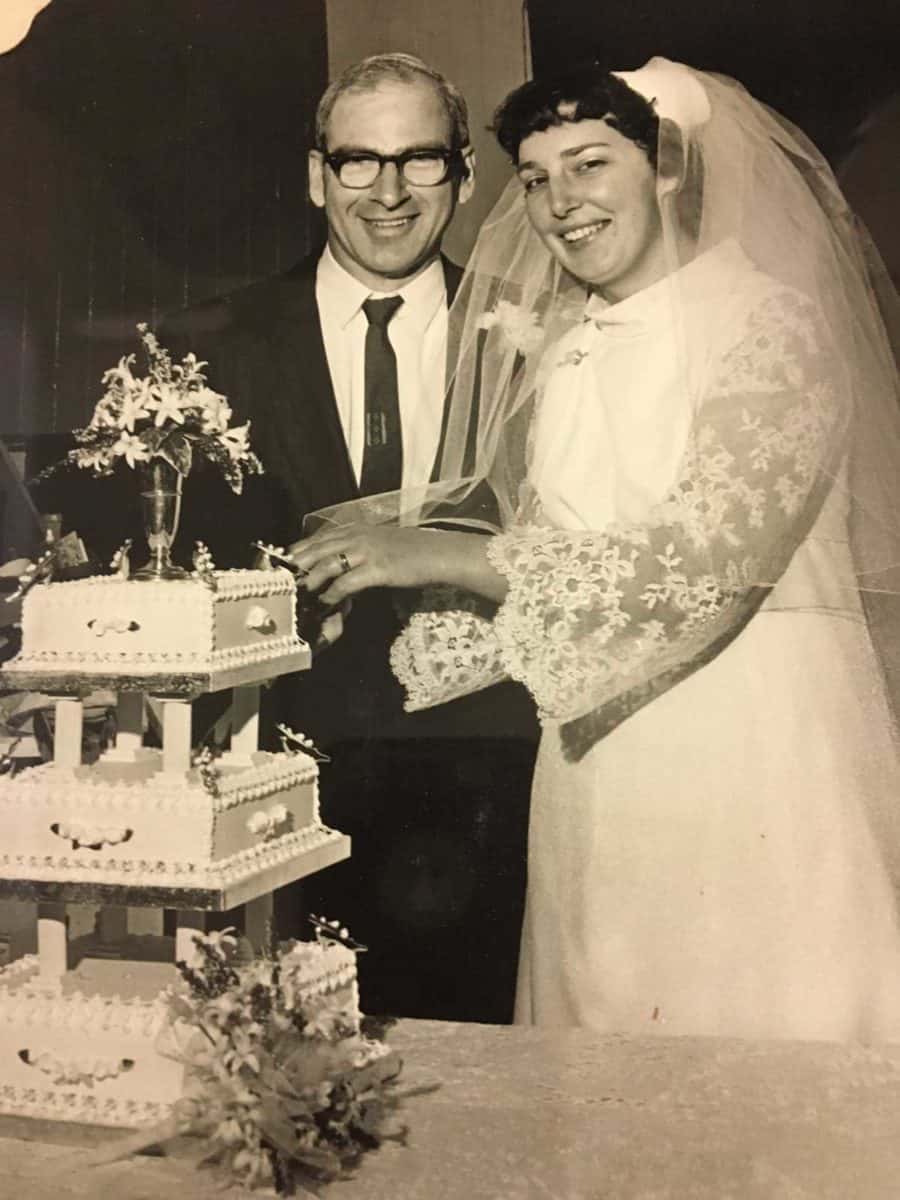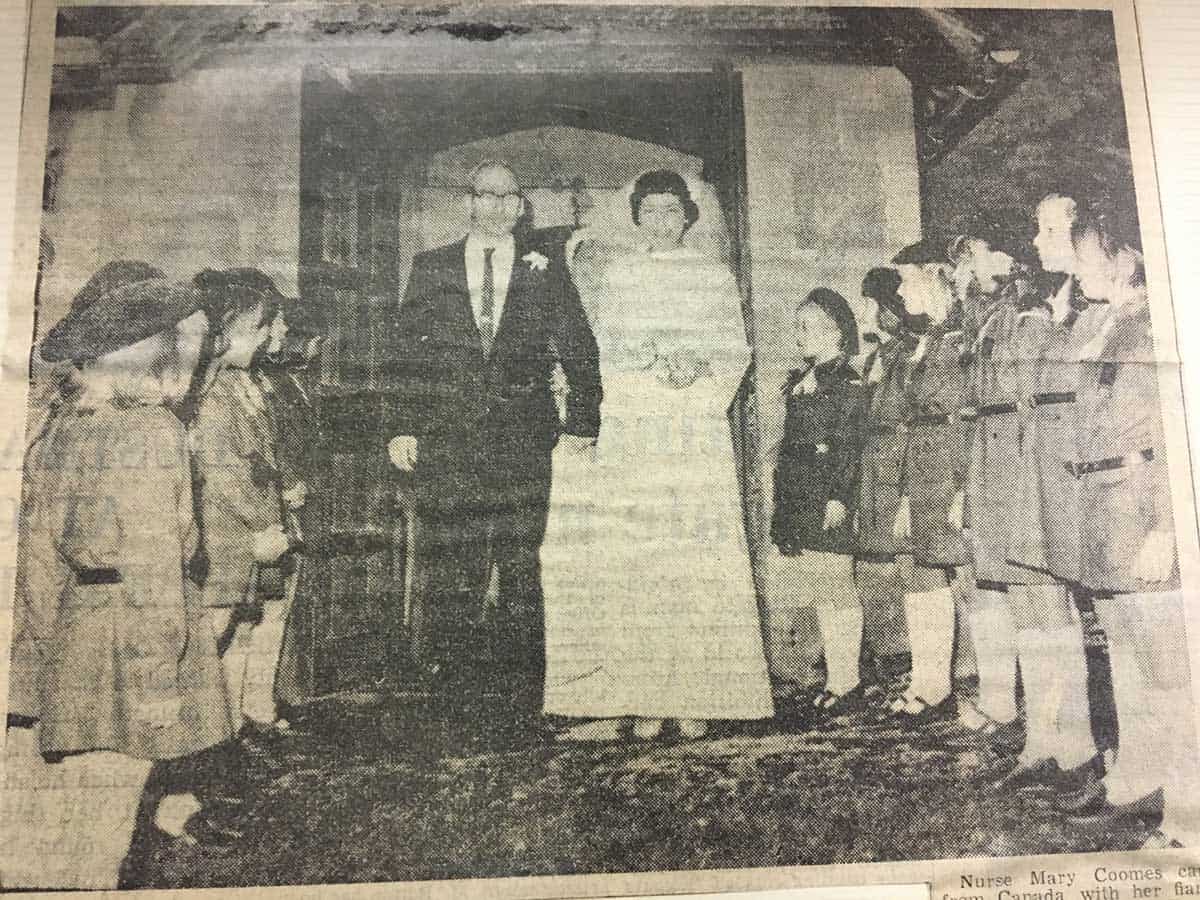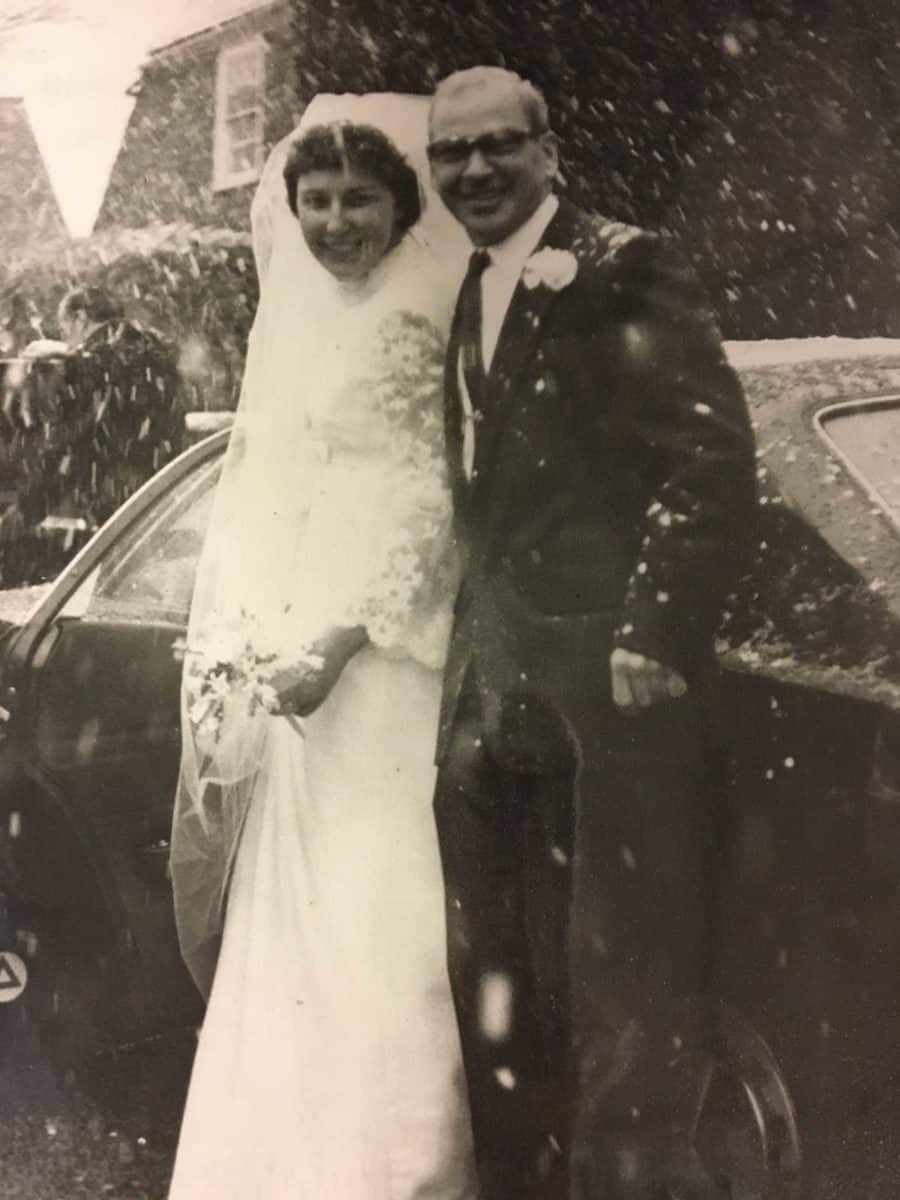KAGAWONG – The fates were obviously smiling when a young English nurse, Mary Coomes, set out on a four-year adventure to the wilds of far-off Canada and Gore Bay snowmobile enthusiast John Buie left his position at the steel plant in Sault Ste. Marie to return home to Manitoulin more than a half-century ago. It seems their paths were destined to cross—both set out on the same date to relocate to Manitoulin, September 27, 1969.
Ms. Coomes had been offered an outpost position with the Red Cross at either Red Lake or Mindemoya; in the end she found herself on a train bound for the Sudbury station where she was met by the hospital caretaker Roy Sloss and Zella McCutcheon, the charge nurse.
For Mr. Buie, however, it was a homecoming. “The mill was on strike and I decided to come home to work at McQuarrie’s in Gore Bay,” he recalled. Meanwhile, the future Ms. Buie settled in to work at the hospital.
Cupid wields his bow in some very inventive ways. Mr. Buie was indulging in one of his favourite pastimes, snowmobiling, when an errant jaunt across some snow-covered lumps at the tail end of March 1971 sent him hurtling from his machine. The sudden interaction with the ground left him with a badly broken clavicle.
“I couldn’t wear the brace so I wound up in a hospital bed,” he recalled. “There was me and a couple of elderly people in the hospital.”
Mr. Buie had some inventive means to keep the nursing staff close at hand. One was the ever-present box of chocolates on the table beside his bed he freely shared. “I had hot and cold running nurses,” he laughed.
But it was something else that captivated the young English nurse. “He told the most marvelous stories,” recalled Ms. Buie. “I worked the afternoon shift from 4 pm to 12 and in those days there wasn’t all that much to do.”

Hours spent sitting by Mr. Buie’s bedside, chatting and listening as he extolled the wonders of her new Island home, helped while away the long hours of her shift. But time passed swiftly and Mr. Buie was eager to leave the hospital and return to work.
“I thought she had left,” recalled Mr. Buie, relating how he was surprised to see her still at the hospital when he went in to visit an ailing relative. Ms. Buie took him into the kitchen to prepare a sandwich.
It took a while for Mr. Buie to screw up the courage to ask her out on a date.
“I wracked my brains trying to come up with something,” he said. There was an added challenge in the hours Ms. Buie worked. “It was smelt season, so I decided to ask her to go smelt fishing.”
“That was our first date, fishing for smelts at midnight,” laughed Ms. Buie. “There I was at three o’clock in the morning cleaning fish.”
“Hey, I helped,” laughed Mr. Buie.
Their second date was a bit more traditional. One of Canada’s favourite musical programs, Don Messer’s Jubilee was playing on the Island.
Then a complication arose.
“I was never one for going out with a lot of boys,” she cautioned, “but before I began courting John, I had invited a young man, a friend’s cousin, to come to visit Canada.” When the young man contacted her to say he was coming over, Ms. Buie found herself at a loss as to what to do.
“I went to see John’s mom and asked her what I should do,” she recalled. “She told John about it. I finally got up the courage to tell John and he said ‘oh I know all about it’.” Thanks to his mother’s intervention, he had time to digest the idea.
In the end it worked out fine.
“I would show him around the Island and I would ditch him at 9 o’clock to go see John,” she laughed. Eventually, they recruited another young woman to the troupe for a visit to Sault Ste. Marie, where John showed them the sights around his former neighbourhood.
When the young visitor had returned to England, there followed many expeditions to remote bays and lakes across Manitoulin in Mr. Buie’s “old blue pickup truck.”

“The roads were pretty bumpy and I was worried about what we would do if we got stuck out there,” recalled Ms. Buie. “But we never broke down,” rejoined Mr. Buie.
The courting lasted only five weeks before Mr. Buie popped the question.
“He went down on one knee,” smiled Ms. Buie.
But then another complication arose; these were the days before email, the internet or many of the other ubiquitous forms of communication to be found today.
“Neither of us had a phone, so John had to ask for my hand in marriage by writing a letter to my parents,” laughed Ms. Buie. Well, through the mail in any event. “I put it down on tape and mailed the tape,” said Mr. Buie. Mailing tape recordings home was fairly common in the heady days when snail mail ruled supreme. The reaction was a little mixed. “My mom asked ‘couldn’t you find an nice English boy to marry?’” she recalled. But the couple’s minds were set and her parents consented to the bond.
The couple travelled to England and Ms. Buie’s hometown of Horley to tie the knot at St. Bartholomew’s Anglican Church.

“It was the church I grew up in,” she said. “It was where my parents were married.” The church was originally built in the 14th century and renovated heavily in the mid-1800s.
The hurdles were not over just yet.
“In those days you had to publish the banns for three consecutive Sundays,” said Ms. Buie, “but we were only going to be in England for two weeks, so we had to have a special licence. That required going to Westminister Abby to fill out the required forms.”
Not commonly heard these days, the word banns is from a Middle English word meaning proclamation and is rooted in old French. Banns are the public announcement in a Christian parish church of an impending marriage between two specified persons.
A normal marriage licence cost $10 in those days, but the special licence hiked that bill to $65.
Not only that, letters from the parents of the bride and groom had to be supplied. Since Mr. Buie’s father had passed away some time before, it fell to his mother to supply the necessary letter.
“My mom got a big kick out of that,” laughed Mr. Buie. “I was 36, so I didn’t find it quite as funny.”
A letter from the local Anglican priest on Manitoulin was also required. “I wasn’t a church going fella, but luckily I like to curl and one of the fellows I curled with was the local Anglican minister.” Good game.
“He wrote a glowing letter about John,” said Ms. Buie.
On the bright side, the couple now has an elegant licence bearing the royal seal of Henry VIII as a souvenir of the moment.
While awaiting the day of the nuptials, Ms. Buie stayed at her parents. “But in those days it just wasn’t done for the groom to stay in the same house before the wedding,” she recalled, “so we put John up at one of the neighbours.”
“They were really the only two people John knew,” chuckled Ms. Buie.
Processing out of the church, Ms. Buie, a lifelong adherent of the Girl Guide movement, was provided with a two-lane honour guard of Brownies. “We didn’t know about that, it was very beautiful,” shared Ms. Buie. The reception was held at the Guide Hall. “My mom and dad had to arrange everything without ever having met John,” said Ms. Buie.
While the engagement and wedding rings were purchased in England, Ms. Buie’s wedding dress was a made-on-Manitoulin creation (courtesy of Evie Kutchaw of Mindemoya), and the veil came from London. As for something blue, Ms. Buie’s grandmother’s silver pin circa 1935 filled the bill.
Other interesting quaint customs included having a photograph taken with the dustman (garbage man for Canadian reference). One customary item had to be left out, however, as the pubs were all closed due to the weather.
Snow in December might be a well-anticipated event on Manitoulin, but in England it comes on a very rare occasion. Just to make Mr. Buie feel more at home the good Lord supplied a blizzard for the occasion. There were also a couple of familiar faces, as Canon Dickson and his wife Edna happened to be vacationing in England at the time and attended the wedding.
The wedding cake was as tradition dictates, a rich fruit cake. “The tradition was that you would keep the top tier and use it for the first christening,” said Ms. Buie. “This we did and it became Neil’s christening cake—he was born on Valentine’s Day 1976. So our first son Neil was born on Valentine’s Day and our daughter Jen’s first born son, Chase, was born on Valentine’s Day 2012.”
The Buies went on to have three children, son Neil, who became a veterinarian, Rob, who is a pilot, and Jen, a physiotherapist.
Upon their return to Manitoulin, the couple held a reception at the church hall in Gore Bay.
“I was alright in England, but when we got here I was expected to make a small speech,” said Mr. Buie. “I wasn’t happy about that.”
The couple settled into the house in Gore Bay that Mr. Buie and his mother had purchased, while his mother moved back into the family home in Providence Bay. “I just switched housekeepers,” chuckled Mr. Buie. The Buies now make their home in Kagawong.
The story of the Buie family is intricately linked with Valentine’s Day and they wouldn’t have it any other way.
“Life has its ups and downs,” said Ms. Buie, “but family and community are very important. We have been very blessed with caring family, friends and community.”






